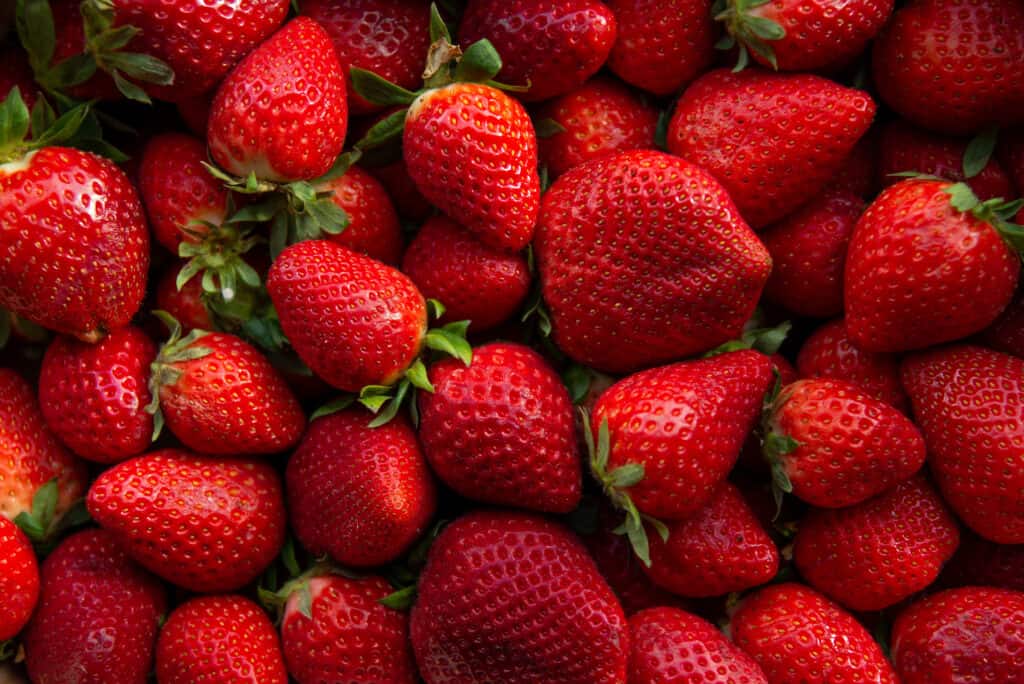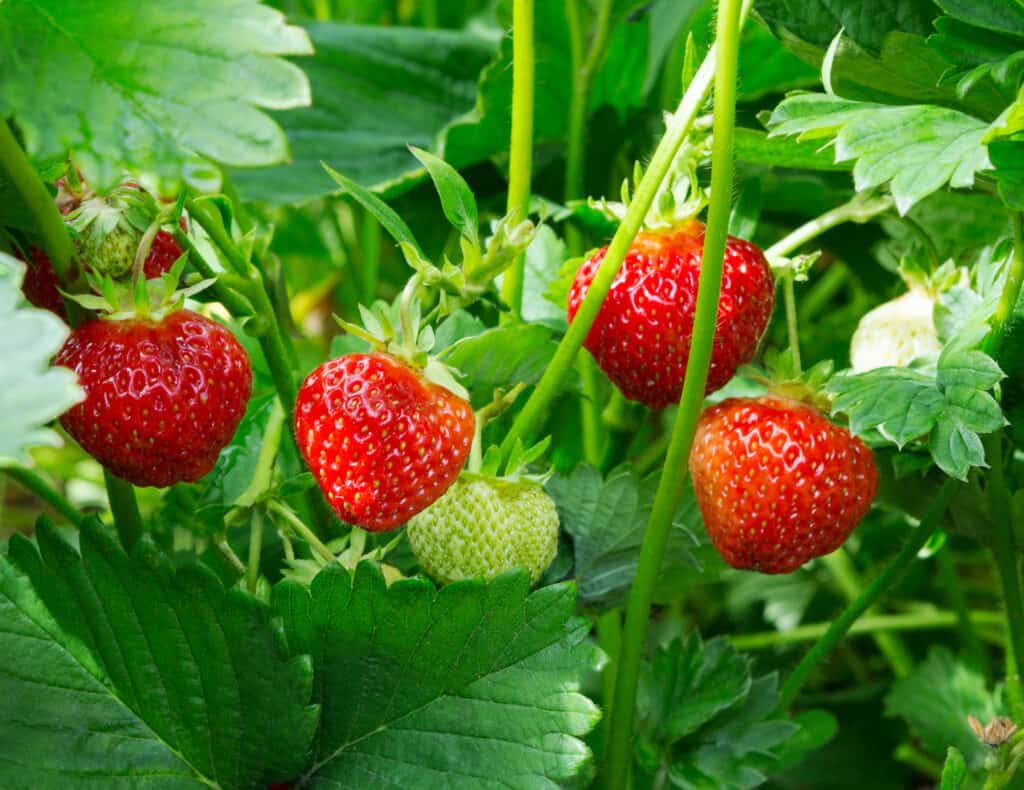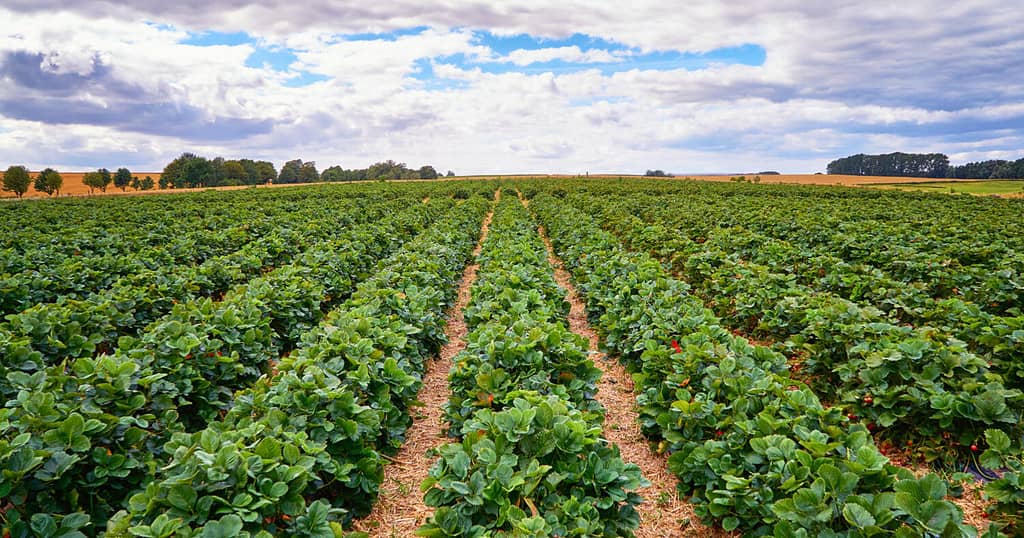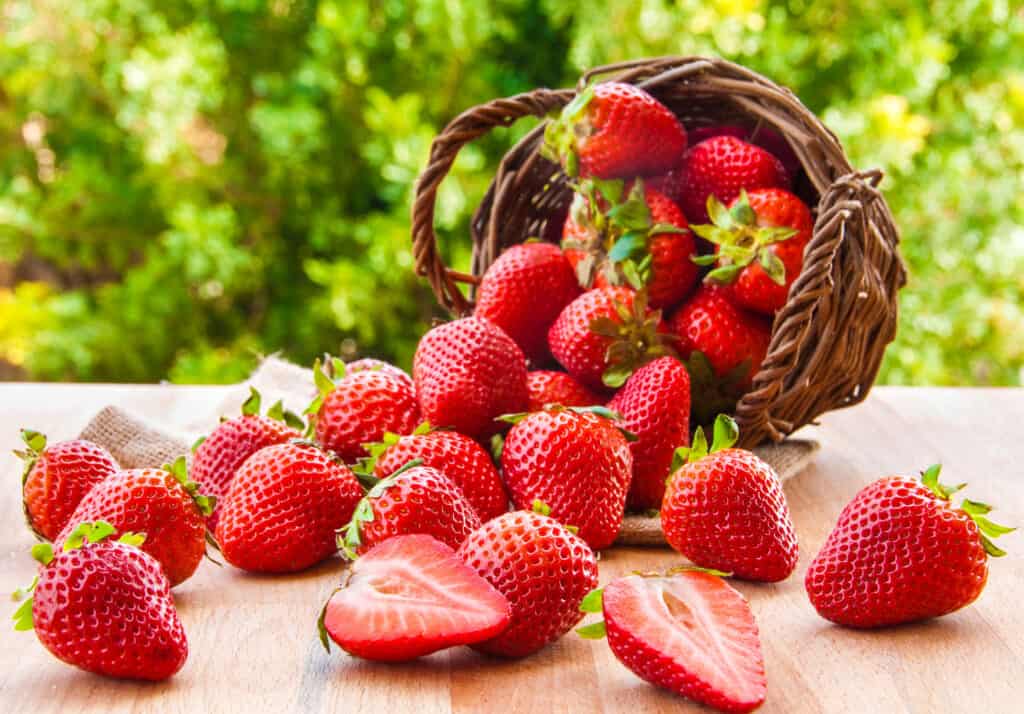If you’re familiar with the climate in Minnesota, you know that the North Star State has short summers and long winters. Because of this climate, you might think that growing strawberries in Minnesota would be challenging. Fortunately, most strawberries are cold-hardy plants. So even if the growing season is shorter, most Minnesotans can still grow strawberries and enjoy the fruits of their labor.
Before planting strawberries in the Upper Midwest, know what growing Zone you’re in first. This knowledge will help you determine the ideal timing for planting and harvesting, as well as which varieties grow best in your climate. We’ll discuss those details below and share additional growing tips for the best, juicy strawberry yields.

Most strawberry varieties are cold-hardy plants, but some survive Minnesota winters better than others.
©Erika Anes/Shutterstock.com
The Best Time to Plant Strawberries in Minnesota
Spring is the best season for planting strawberries in Minnesota. However, the peak timing can differ depending on your local USDA Hardiness Zone.
Minnesota spans five USDA Hardiness Zones: 3a, 3b, 4a, 4b, and a small area in 5a. Because of the differences in climate, a strawberry garden in Zones 3a–4b will require slightly different planting timing than one in Zone 5a.
What about the coldest places in Minnesota that span more than one growing Zone? It’s probably best to base your planting plans on the coldest local Zone.
We’ve provided a table below with optimal strawberry planting times in each of Minnesota’s Hardiness Zones.
| Minnesota Hardiness Zones (North to South) | Peak Timing for Strawberry Planting |
|---|---|
| Zone 3a | Mid April to Early May |
| Zone 3b | Mid-April to Early May |
| Zone 4a | Mid-April to Early May |
| Zone 4b | Mid-April to Early May |
| Zone 5a | Mid-March to Early April |
In mid-to-late spring, the soil becomes workable and ideal for establishing healthy strawberry plants. So aim to have your strawberry seedlings or transplants in the ground well before summer begins.

Minnesota growers in Zones 5a, 4a, and 4b might produce more strawberry crops than those in the most northern Zones due to the milder climate.
©iStock.com/romiri
The Best Regions in the State for Strawberry Crops
Minnesota’s south and central regions (Zones 5a, 4a, and 4b) have the best luck with strawberry crops because of the warmer climate.
Zones 5a, 4b, and 4a: The Southeast, South Central, Southwest, West Central, and Twin Cities Metro regions of Minnesota have the mildest winters in the state. So these regions have longer growing seasons that allow for higher strawberry yields, depending on the type of plant. The further south you go in the state, the longer the growing season.
Zones 3b and 3a: These are the northernmost regions of the state (the Northeast and Northwest), with shorter growing seasons and harsher winters. However, you can still grow strawberries in northern Minnesota! You’ll just have a shorter growing season and perhaps a more difficult time overwintering some of these perennial plants.

Most strawberry growers cut the earliest blossoms off their plants to produce higher yields.
©4028mdk09 / CC BY-SA – License
The Best Strawberry Plants to Grow in Minnesota
When choosing the best strawberries to grow in Minnesota, you first need to know which of the three main types you want to plant. Then select a cold-hardy variety to grow.
The Main Types of Strawberries
June-bearing: This type of strawberry produces one large crop per growing season. The peak timing for June-bearing strawberries is usually June or July. However, some varieties are ready to pick early, and some provide berries later in the season.
Day Neutral: The day-neutral strawberry is a continuous provider. These plants keep producing more berries throughout most of the growing season. However, the yields for this type of strawberry may end up being smaller overall than the one big harvest that June-bearing strawberries provide.
Everbearing: An everbearing strawberry plant usually produces two crops during the Minnesota growing season; one early and one late.
Cold-Hardy Strawberry Varieties
Growing cold-hardy strawberries in Minnesota will help ensure your plants survive through the winter to produce more berries next year. And these strawberries might provide higher yields during Minnesota’s shorter growing seasons.
Here are 10 June-bearing strawberry varieties that are cold-hardy and produce great-tasting berries in Upper Midwest climates:
| Strawberry Variety | Berry Size | Ready to Harvest |
|---|---|---|
| Annapolis | Medium | Early Season |
| Itasca | Medium | Early Season |
| Sable | Small to Medium | Early Season |
| Veestar | Small | Early Season |
| Cavendish | Large | Midseason |
| Kent | Medium | Midseason |
| Mesabi | Medium to Large | Midseason |
| Glooscap | Medium | Midseason |
| Bounty | Medium | Late Season |
| Winona | Large | Late Season |

The ideal timing for harvesting strawberries varies for different plant types and varieties.
©DR pics/Shutterstock.com
When do you harvest Minnesota strawberries?
Depending on the plant variety, Minnesota strawberries are usually ready to pick between early summer and the first autumn frost. However, the peak season for each type of strawberry can vary by many weeks. So it’s essential to know the growth habits of your specific plants.
For example, the Earliglow strawberry is a June-bearing plant that produces berries in early June in Zones 2–7. But the June-bearing strawberry called AC Valley Sunset has one big crop in late June to early July in Zones 4–7.
Before you plant strawberries, note the berry variety and its peak harvest timing so you’ll know when to expect the juiciest crops from each.

Strawberry plants grow shallow roots that are prone to disease when overwatered.
©goja1/Shutterstock.com
10 Helpful Tips for Growing the Best Strawberries
1. Start with the best soil.
Strawberry plants are reasonably adaptable to different soil types, but the best soil is vital for producing the best crops. When possible, provide your strawberry plants with sandy loam soil or soil mixed with sandy loam and organic matter. You can purchase bagged sandy loam from gardening centers and online retailers.
You can also amend your current soil by adding organic matter (fertilizer). If you’re not sure of your soil’s quality, have it tested.
The best soils for strawberry plants need the right balance of nutrients, including potassium, phosphorous, and nitrogen.
2. Consider using raised garden beds.
If your garden soil is dense, hard, or rocky, consider planting strawberries in raised beds for easier management of soil drainage. And you definitely want well-draining soil to grow successful strawberry plants!
3. Don’t bury the plant crown.
The roots of a strawberry plant start below the base of the plant called a crown. You want to make sure that you don’t bury their crowns under the soil when planting your strawberries.
The crown is a thick stem that looks like part of a root itself. At the top of the crown are the growth points for the light green stems above. So, when you place the plant in the ground, make sure that all of the growth points for new stems are above the soil.
4. Give them lots of sun.
Strawberries need 6–8 hours of sunlight per day, so plant them in a sunny spot for the largest crops of juicy fruit.
5. Give plants lots of room to spread.
Plant your strawberries about 12–18 inches apart to allow them room to spread. Most strawberry plants will also shoot out some runners that develop into new plants. If you want to keep some of those runners intact, you’ll need space between plants for them to expand and develop new plants.
6. Mulch your plants. Then mulch them again.
Adding mulch around your strawberry plants after planting helps keep them healthy by keeping the soil moisture more balanced. You should also mulch around the plants again every fall to protect them during the winter months from freezing temperatures.
7. Water regularly, but not too much.
Strawberries grow shallow roots that can develop diseases like root rot if the plants are overwatered. But they also need consistent watering, especially during their peak fruiting weeks.
On average, give your strawberry plants 1–1.5 inches of water per week until they start bearing fruit. Then your plants may need an inch or two of water per day until peak season is over.
Keep an eye out for any yellowing leaves and drooping plants, which could indicate overwatering.
Consider using a soaker hose that drips water into the ground around the plants. The soaker hose helps prevent the soil from getting soggy when used properly.
8. Remove the early blossoms and most runners.
Cutting the earliest blossoms off your new strawberry plants helps them put more energy into making juicy berries. This is also a benefit of removing most of the runners that the plant will develop over time. With proper early pruning, your plants should later become leafier and produce more fruit.
Remove all blossoms that appear on the plants in their first few weeks. Then let all the new blossoms beyond that point stay on the plants and eventually turn into strawberries.
9. Cut back strawberry plants in the summer, not the fall.
Only cut back your strawberry plants during the growing season after they have finished producing berries. If you wait until fall to cut them back, you risk them not surviving the winter.
When you do cut them back, leave about 2–3 inches of the plant stems intact. The strawberry plants should start growing leaves again before winter comes.
Also, clear out any weeds, runners, and extra plants that might crowd the ones you intend to overwinter. Strawberries don’t compete well for space with neighboring plants, so make sure they have plenty of room, even for winter prep growth.
10. Fertilize in the fall after harvesting all the berries.
Help your plants stay healthy over the winter by treating them to some balanced fertilizer in the fall. Do this before adding the fall mulch below the plants.
Your main goal with fertilizer is to make sure the soil has enough nitrogen. Applying a balanced fertilizer is one way to achieve that goal, but you can also amend the soil with the following:
- multi-purpose compost (peat-free)
- soil-based compost
- blood meal

The key to successful Minnesota strawberries is growing plant varieties that are hardy in the local climate.
©iStock.com/MariaUspenskaya
Growing strawberries in Minnesota is easier with the right plants.
When you start with cold-hardy strawberry plants that have already proven successful in your Zone, it’s much easier to produce amazing berries. So do your research before planting and order the best varieties for Zones 5a–3b, or whichever is best for your local climate. In addition, get advice from local gardening organizations with experience growing strawberries.
Also, contact the University of Minnesota’s Department of Horticulture Science for tips from their over 50 years of research! The scientists at U of M have proven that growing strawberries in Minnesota can be a very successful and rewarding experience.
The photo featured at the top of this post is © Tim UR/Shutterstock.com
Thank you for reading! Have some feedback for us? Contact the AZ Animals editorial team.






